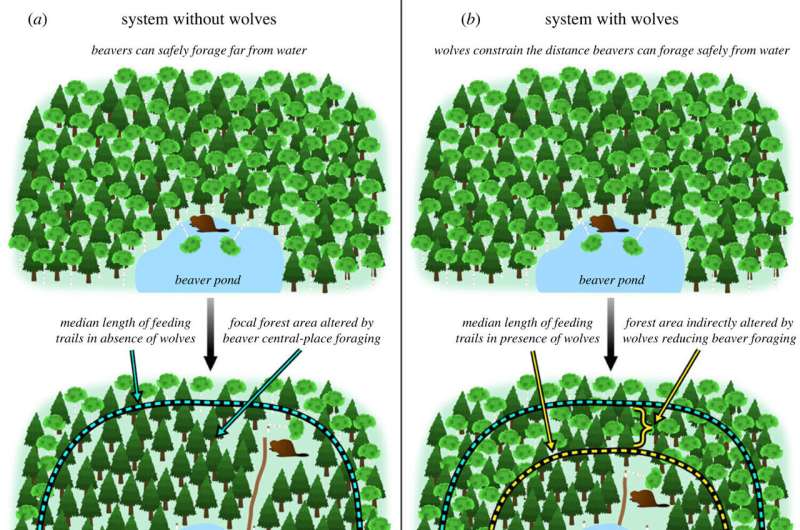November 14, 2023 report
This article has been reviewed according to Science X's editorial process and policies. Editors have highlighted the following attributes while ensuring the content's credibility:
fact-checked
peer-reviewed publication
trusted source
proofread
Examining the role wolves play in boreal forest dynamics as they constrain beaver movements

A team of land managers at the University of Minnesota, working with a colleague at the University of Manitoba, has learned more about the role wolves play in boreal forest dynamics as they prey on beavers. In their study, published in Proceedings of the Royal Society B, the group used GPS trackers on wild wolves and cameras placed around several beaver ponds at a forested park in Minnesota to learn more about the impact of beavers and wolves on forest dynamics.
Prior research has shown that beavers play a major role in forest dynamics because they clear land, dam streams and forage on areas around beaver ponds. Prior research has also suggested that wolves may alter the impact that beavers have on forest dynamics by preying on them when the beavers stray too far from their self-built lodges—giving wolves a role in forest dynamics. In this new effort, the research team took a closer look to determine the impact wolves have on forest dynamics by preying on beavers.
The work involved capturing and GPS tagging multiple wolves over the years 2015 to 2022 as part of the Voyageurs Wolf Project, being conducted in Voyageurs National Park. The tags allowed the research team to track the movements of the wolves, particularly when they ventured near beaver ponds. The researchers also set up multiple remote cameras around several beaver ponds during the same period, allowing them to monitor the movement of both beavers and wolves.
The research team visited the beaver ponds periodically, noting the lengths of beaver feeding trails, dead animal remains and the amounts of fecal deposits left by both animals. By combining the data, they were able to identify the areas where they wolves preyed on beavers and the means by which the beavers protected themselves.
The researchers found that the beavers responded to the presence of wolves in their area by using shorter feeding trails, which led to reductions in the size of foraging areas around beaver ponds. This, they contend, shows that wolves play a role in boreal forest dynamics by incidentally reducing the size of the "halo" around beaver ponds. They found that the presence of wolves altered approximately 23 to 47 acres of forest land in the park.
More information: Thomas D. Gable et al, Wolves alter the trajectory of forests by shaping the central place foraging behaviour of an ecosystem engineer, Proceedings of the Royal Society B: Biological Sciences (2023). DOI: 10.1098/rspb.2023.1377
Journal information: Proceedings of the Royal Society B
© 2023 Science X Network


















